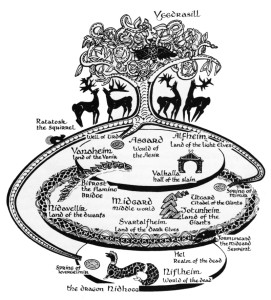Asgard, in Norse mythology, is the abode of the gods. Access to Asgard was possible only by crossing the bridge Bifrost (the rainbow).
Asgard was divided into 12 or more realms in which each principal god had his own luxurious mansion of gold or silver. The most important palace was Valhalla, the home of Odin, the chief of the gods.
Asgard, in Norse mythology, is one of the nine worlds and the homeland of the Aesir, the race of warrior gods. Located on the highest level of the Norse universe, it is surrounded by a high wall of closely fitted stone block
The walls surrounding Asgard were built by Blast (or Hrimthurs), who asked in payment the hand of Freyja plus the sun and the moon. Odin agreed providing the walls be complete in six months. Hrimthurs had a magic horse, named Svadilfari, who helped him in his work. To Odin’s (and the other gods, especially Freya’s) horror, with but a few days left, Blast was almost finished. Loki, the trickster, turned himself into a mare and beguiled the stallion Svadilfari away. The job was not completed in time and no payment was given.
Also found on this level are the worlds of Alfheim and Vanaheim as well as Valhalla, an immense hall where warriors slain in battle await the final conflict.
In the middle of Asgard lies the plain of Idavoll (or Ida) where the Aesir meet to decide important issues. There the gods assemble in the hall of Gladsheim and the goddesses in the hall of Vingolf.
The gods also meet daily at the Well of Urd, beneath the Asgard root of the ash tree Yggdrasil.

